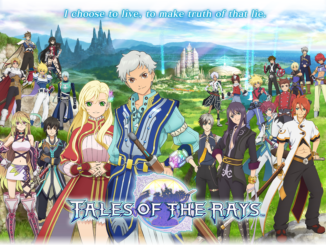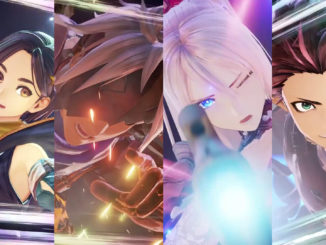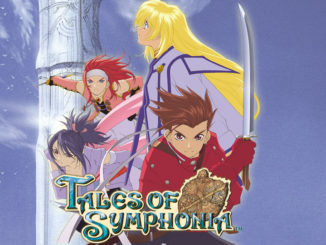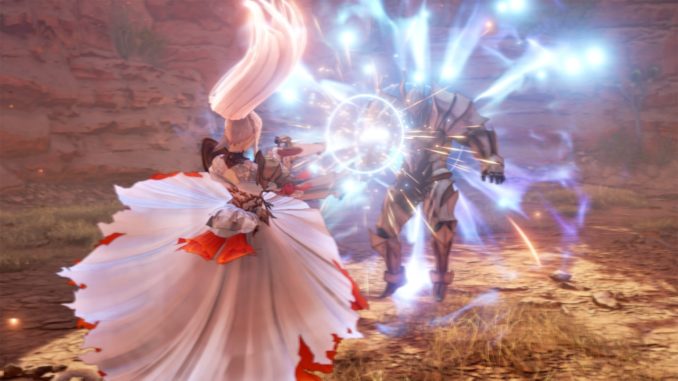
With the release of over seven minutes of new Tales of Arise footage and more on the official site, fans have gotten their first look at several of its new features. But while Arise may be a new approach for Tales, many of its ideas come from its predecessors, refined and adapted for its own vision.
AG: The Old New Combos

This row of diamonds may look like Berseria's Soul Gauge, but it has a lot more in common with Destiny's Chain Capacity, or CC. The diamonds even fill up from the left, but the partial bar is only to show how fast the points return (a feeling that should be familiar to those who played Graces).
More importantly, different artes in Arise take different amounts of AG. We see Alphen combining strikes that spend 1 and 2 AG from his pool of 4. Shionne's and Rinwell's spells take 2 as well. Why is this a big deal?
In Xillia, Zestiria, and Berseria, a combo could be the same number of artes no matter what those artes were. More powerful artes only costed more TP, SC, or SG. In Destiny, on the other hand, artes with higher CC costs affected the combo in an immediate way. You may want to stun the enemy with a 3-CC Lion's Howl, but if you only have 5 CC, you have to think carefully about what goes before and after it.
The main difference in Arise is that basic attacks cost no AG. You can use them to set up or connect a strike arte however you like. But when you pick your moment to land a powerful special attack, its AG cost will be an important consideration.
Boost Attacks: A Brief History of Assists
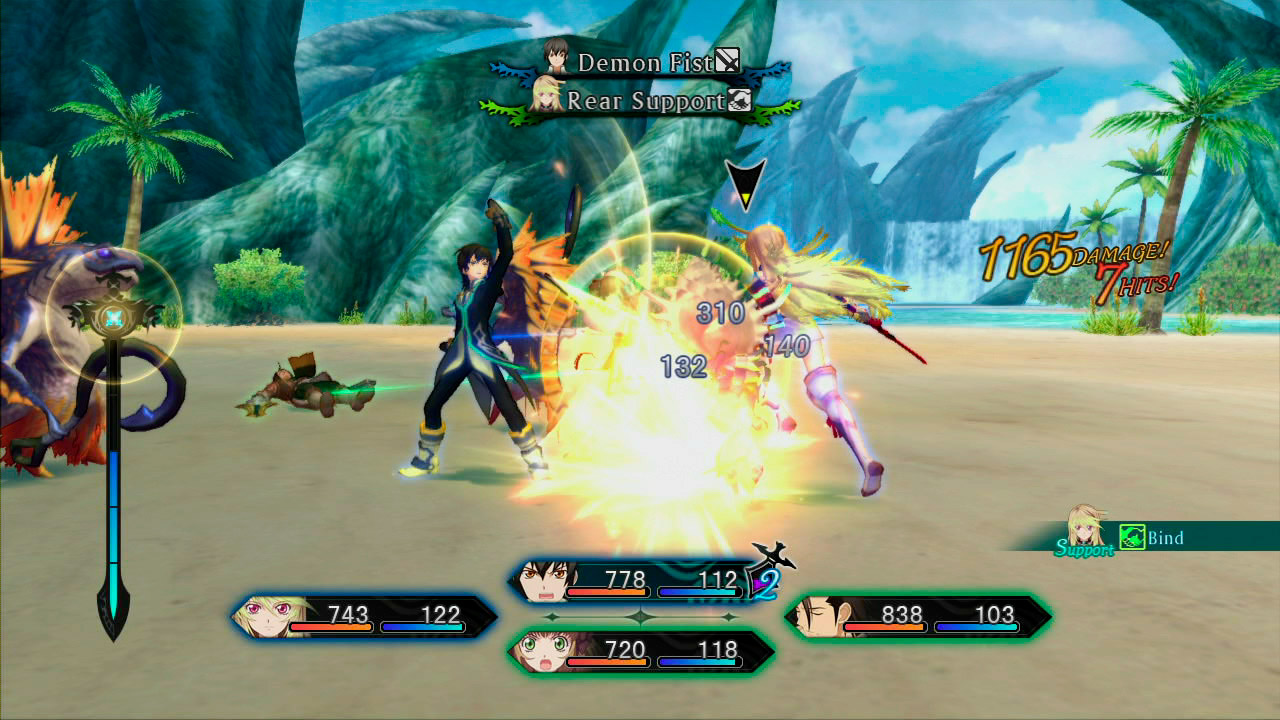
Boost Attacks are the latest in a long line of mechanics in Tales that allow you to command your party. This is likely a factor in the decision to make Arise a single-player game, so let's talk about the ups and downs of team tactics and where Arise zags.
The ability to set shortcuts to command your allies to do certain moves goes all the way back to Phantasia. The feature has mixed interactions with multiplayer—in some games, it will take over the commanded character, but in others, the player gets priority. Many players simply use the commands on the character they're playing, turning them into additional arte slots and using the menu for the AI.
Tapping other characters to supplement your own became a central mechanic in Tales of Xillia and its sequel. Using the Link system on a second character grants you some of their skills. They also automatically join your attacks and can follow your actions with a unique Support Skill. Linking to a character makes them impossible to play by a human, since it completely takes over their behavior.
A form of linking also goes back to Tales of Phantasia: Narikiri Dungeon X. The twins or Kruelle could be commanded to use the Chain Partner skill to temporarily synchronize their attacks with the player character. Kruelle would even shapeshift and get extra benefits from assisting a character this way. (As a PSP game, NDX was single player.)
Zestiria pairs its characters, but the effect is a bit different. The Partner Blast power allows a character to summon their partner mid-combo for a special attack. The Armatus system absorbs them completely. However, outside of these systems, a partner can act independently whether human or AI.

In Arise, there's no pairing. Instead, you can activate your own Boost Attack or any other characters' at any time, provided their personal Boost charge is ready. An ally's Boost seems to support the leader—when Alphen calls on Shionne's, she teleports behind him before firing her barrage.
This is a more holistic form of party play. Your options always include the Boosts of not just a partner but all of your allies. This is actually more invasive to multiplayer in some ways. But depending on how the Boost system develops, it could be a much richer tactical experience for the party leader.
Boost Strikes: Fatal Finalities

Boost Strikes in Arise are a special finishing move. Once a gauge (shown over the target marker) fills up, a "Strike!" indicator activates and the Boost Strike can be used for free. Two characters pair up to finish the enemy with a dynamic Mystic Arte-like assault.
We don't know just how the Strike gauge works, but the idea seems similar to Tales of Vesperia's Fatal Strikes. Attacking the right way opens the enemy up to a stylish finish that grants extra bonuses over a normal kill. Fatal Strikes could also be used on bosses for heavy damage, but Arise hasn't demoed a boss fight yet. Like Fatal Strikes, Boost Strikes could also get extra bonuses and effects from skills.
If that's the effect of a Boost Strike, the animation itself is reminiscent of Finalities in Tales of Rebirth. That game's stand-in for Mystic Artes was also a finisher, only triggering at the end of combat. Like Boost Strikes, Finalities were cooperative attacks between pairs of characters, each combining their powers in a different way.
Not all pairs in Rebirth could use Finalities. They were always between a front-line fighter—Veigue, Eugene, or Tytree—and a spellcaster—Mao, Annie, or Hilda. This isn't confirmed for Arise, but the only Boost Strikes that have been shown are Alphen/Shionne, Alphen/Rinwell, and Law/Rinwell. If this is indeed following in Rebirth's footsteps, it may suggest some predictions about the remaining two playable characters. Tune in next month for the thrilling conclusion.
Titles and Skills: Freedom of Choice

Titles and skills are both Tales mainstays, but when they go together, it's hard not to think of Tales of Graces.
In Graces, each title came with a set of skills, unlocked in order by earning SP and finishing with a boost to the title's passive bonus. Titles themselves came from a variety of sources, whether fighting, exploring, crafting, or just playing the game. Often, they'd give skills that matched how they were earned, like a poison themed title that improved poison resistance.
We see one title in Arise, with five skills of its own. These are a mix of passives and artes, available to buy with SP. In addition, mastering all the skills on the title grants an additional, seemingly permanent passive bonus.
This looks like a simplification of Graces. Each title still adds options, making them appealing to unlock. But instead of earning your way up, you can simply choose to prioritize new moves or buffs as you like. The title shown is a story title with a general spread of abilities, but specialized "achievement titles" are a Tales tradition and ones like in Graces would fit right in with the skills in Arise.
What's To Come
There's definitely a lot of new territory in Arise. The decision to drop local co-op play, whatever the reasons, will be controversial. Less clear are the changes to gels, arte categories, and controls. Crafting equipment in Tales has taken every kind of form. The CP system that controls Shionne's healing powers, among other things, is a total unknown.
Still, there's a lot that's familiar in Tales of Arise. Even the spells are mostly classics, just with new and enhanced visuals. The same goes for many strikes—Demon Fang, the most classic of classics, has a new effect for crawling along the ground.
The truth is that change and experimentation has always been the Tales identity. Any game may be familiar, but it's just as likely to only share a few names with the previous titles. Arise is definitely taking notes from its predecessors, but it's also going to be a new adventure.
Tales of Arise
is now available at the following shops (Note: Please keep in mind that we may receive a commission when you click on our links and make a purchase. This, however, has no bearing on our reviews and comparisons.): North America:
North America:
- Bandai Namco Store - Collector's Edition | Regular Edition
- Amazon US - Regular Edition
- Amazon CA - Regular Edition
- BestBuy - Regular Edition
- Play-Asia
 Europe:
Europe:
- Bandai Namco Store - Collector's Edition | Regular Edition
- Amazon UK - Collector's Edition | Regular Edition
- Amazon France - Collector's Edition | Regular Edition
- Amazon Germany - Collector's Edition | Regular Edition
- Amazon Spain - Collector's Edition | Regular Edition
- Amazon Italy - Collector's Edition | Regular Edition
- Play-Asia
 Tales of Arise is the latest mothership title (new classification: original title) of the Tales of Series which was first announced during Microsoft’s Press Conference in E3 2019. The game was released for the PS5, PS4, Xbox Series X, Xbox One and PC Digital via Steam on September 9, 2021 for Asia and Japan and September 10, 2021 for the rest of the world. The game features use of the Unreal Engine 4 and works on the theme of tradition versus evolution of the series.
Tales of Arise is the latest mothership title (new classification: original title) of the Tales of Series which was first announced during Microsoft’s Press Conference in E3 2019. The game was released for the PS5, PS4, Xbox Series X, Xbox One and PC Digital via Steam on September 9, 2021 for Asia and Japan and September 10, 2021 for the rest of the world. The game features use of the Unreal Engine 4 and works on the theme of tradition versus evolution of the series.
Info Page | News | Gallery | Official Website (US) | Official Website (JP)


